FRIDAY, 28 APRIL 2017 - Those words have an interesting parallel to work being carried out today, as scientists look to the Moon to help gain an accurate understanding of the weather and climate on Earth.
NEED FOR ACCURACY
EUMETSAT operates a fleet of meteorological and climate monitoring satellites and processes and disseminates data and products from the instruments they carry to users such as the National Meteorological Services of its Member States, researchers and to users of the EU’s flagship environmental programme, Copernicus.
These users require highly accurate data.
EUMETSAT Remote Sensing Scientist in charge of calibration of visible and near-infrared bands Dr Sébastien Wagner said that, in the case of monitoring and detecting the signatures of climate change, small radiometric signals can have large policy implications.
For this purpose, it is crucial that satellites’ instruments are calibrated with high accuracy – ideally within a few tenths of a percent.
As satellites’ onboard instruments degrade over time, real changes on the Earth’s surface must be distinguished from changes in a sensor’s response, Wagner said.
WHY USE THE MOON AS A CALIBRATION TARGET?
Features including the Moon’s lack of atmosphere and the stability of the lunar surface give it a number of advantages over using sites on Earth to calibrate instruments in space.
“The Moon is a target that is extremely stable and for which you can really predict its illumination,” Wagner said. “You can model the signal that will come from the Moon and that gives you the possibility to monitor the way your instruments are degrading with time.”
The Moon’s changes in brightness are periodic and predictable, and it can also be observed from any Earth orbit, although some manoeuvres might be required of low-Earth-orbiting satellites.
However, to use the Moon as a calibration target, a model is needed to predict its brightness under any observational conditions.
THE LUNAR CALIBRATION REFERENCE
To develop such a model, continuous observations of the lunar cycle, under clear observational conditions, and the ability to control in time the calibration of the telescopes making the observations, are necessary.
The United States Geological Survey (USGS) developed the Robotic Lunar Observatory to support NASA’s Earth observation missions, using two telescopes with 32 spectral bands altogether over a period of about eight years.
This USGS ROLO model is the current standard for lunar calibration. To take another step forward towards using a common and agreed lunar calibration reference based on the USGS ROLO model has been an international effort.
In December 2014, EUMETSAT hosted a workshop involving 14 agencies from Europe, America and Asia to work towards common implementation of the model (the so-called GSICS Implementation of the ROLO model, or GIRO), share expertise, provide a validated and traceable version of the model and, for the first time, generate a reference dataset for validation and comparisons, the Global Space-Based Inter-Calibration System (GSICS) Lunar Observation Dataset (GLOD).
Data from at least 30 instruments from European, American and Asian satellites have been provided for the dataset. These include imagers, such as EUMETSAT’s Spinning Enhanced Visible and Infrared Imager (SEVIRI), which provides data crucial for models nowcasting severe weather events, and instruments measuring ocean colour and aerosols, among others.
Although EUMETSAT has taken on a major role in the project, keeping it moving forward and developing the source software code for the GIRO and collecting the datasets for the GLOD, the work has been a truly international team effort, Wagner said.
Together, they have developed the GIRO, an agreed international reference for lunar calibration, traceable to the USGS ROLO model.
THE BENEFITS IN PRACTICE
Wagner said one of the major advantages of this international approach has been the sharing of data and understanding of the issues relating to lunar calibration. With all of the partners having an agreed reference, the level of uncertainty in relation to data can be reduced to very low levels.
In March 2017, a major milestone in the project was reached when EUMETSAT made the source code of the GIRO and the GLOD available to its international partners.
Analysis of the resulting observation datasets will be used to improve the lunar irradiance model. This will be discussed at a follow-on workshop to be held in Xi’an, China in November 2017, which aims to address the increasingly challenging calibration needs for the next generation of satellite instruments.
Image: The moon appears in an image captured by the SEVIRI instrument on a EUMETSAT Meteosat Second Generation satellite.
Subscribe to our newsletter
Stay updated on the latest technology, innovation product arrivals and exciting offers to your inbox.
Newsletter

